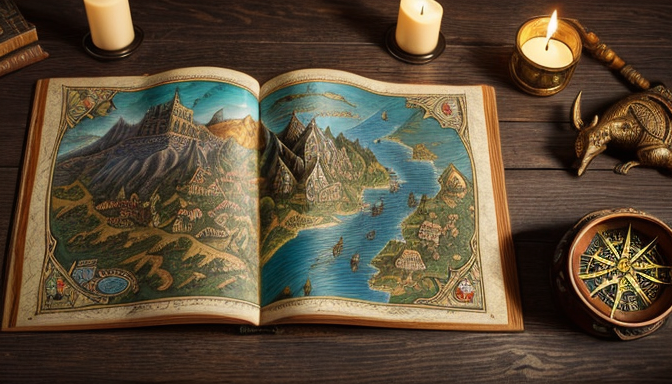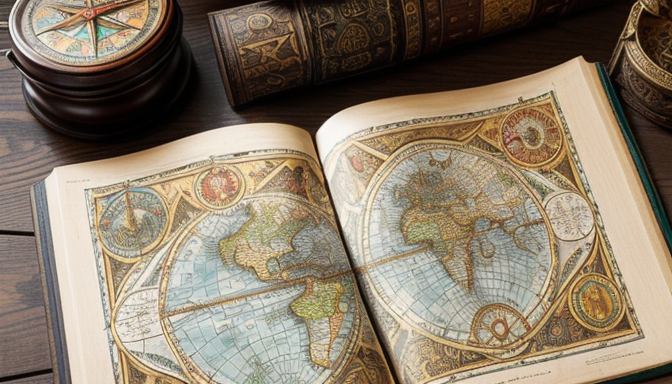When we think of fantastical realms, our minds often drift to the stunning maps that accompany them. These cartographic wonders are not merely tools for navigation; they are the very blueprints of imagination, inviting us to explore lands teeming with adventure, mystery, and magic. Whether it’s the sprawling landscapes of Middle-earth or the enchanted territories of Narnia, these maps breathe life into the stories we love. They serve as visual storytellers, guiding us through intricate plots and allowing us to envision the landforms, kingdom borders, and unique realms that define these narratives.
Take a moment to consider the significance of a well-crafted map. It’s like a portal into another world, where every mountain peak and winding river tells a story of its own. For instance, the map of Westeros from George R.R. Martin’s “A Song of Ice and Fire” not only illustrates the geography but also reflects the political tensions and cultural diversity of the Seven Kingdoms. Such maps are meticulously designed, often featuring
- **Legendary landmarks**
- **Detailed topography**
- **Cultural regions**
that enhance our understanding of the narrative.
In essence, fictional maps are a vital part of world-building, enabling readers to immerse themselves fully in the tales spun by their favorite authors. They ignite our curiosity, making us feel like explorers in uncharted territories. So, the next time you dive into a fantasy novel or embark on a cinematic journey, take a moment to appreciate the artistry behind these cartographic masterpieces that shape our adventures.
The Enchantment of Literary Maps
When you crack open a book and flip to the first page, you might not realize that a magical journey awaits you, often guided by a map. Literary maps are not just decorative; they are gateways to otherworldly realms, enriching our experience as readers. Think of J.R.R. Tolkien’s Middle-earth or C.S. Lewis’s Narnia—these maps aren’t just lines and shapes; they’re blueprints of adventure.
These enchanting maps help us visualize the landforms, kingdom borders, and realms that exist in the authors’ imaginations. For instance, in Tolkien’s work, the detailed geography of Middle-earth allows readers to trace the paths of beloved characters like Frodo and Gandalf, making the journey feel all the more real. The mountains, rivers, and forests are not merely background; they play a pivotal role in shaping the story’s narrative and character development.
Moreover, maps can evoke a sense of nostalgia and wonder, as they often remind us of our own childhood adventures in imaginary lands. They serve as a visual anchor, allowing us to immerse ourselves deeply in the story. When we see a map, we can almost feel the wind in our hair as we traverse through enchanted forests or scale towering mountains. It’s this connection that makes literary maps so powerful, turning mere words into a vibrant canvas of imagination.

Maps in Film and Gaming
Maps in film and gaming are more than just pretty pictures; they are the blueprints of entire universes! These carefully crafted visuals serve as a bridge between the audience and the story, guiding us through vast landscapes filled with adventure and intrigue. Think about it—when you look at a map from your favorite video game or movie, it’s like holding a treasure map that leads you to hidden secrets and epic quests.
Take, for example, the iconic map of Middle-earth from The Lord of the Rings. This map is not just a backdrop; it’s a crucial part of the storytelling. It helps viewers and readers understand the vastness of the world, the distances characters must travel, and the various realms they encounter. Each mountain, river, and forest is a piece of the puzzle that enriches the narrative. Similarly, in games like The Legend of Zelda, the map evolves as players progress, revealing new areas and challenges, making the world feel alive and responsive.
In film, maps often serve as a visual guide during critical moments. For instance, in Harry Potter and the Deathly Hallows, the Marauder’s Map provides not just directions but also a sense of security and connection to the Hogwarts universe. It’s a reminder that every corner of that world is filled with history and magic.
Ultimately, whether in films or games, maps are essential tools for immersive worldbuilding. They allow us to explore realms we could only dream of, transforming our imagination into a tangible journey. So next time you dive into a new story, take a moment to appreciate the map—it’s the key to unlocking the adventure!
Frequently Asked Questions
- What makes fictional maps so captivating?
Fictional maps are like treasure maps for our imagination! They provide a visual representation of the worlds we read about or watch, allowing us to explore and connect with the story on a deeper level. Whether it’s the intricate details of Middle-earth or the sprawling landscapes of a video game, these maps help us visualize the adventure.
- How do maps enhance storytelling in literature?
Maps in literature act as a visual anchor, guiding readers through complex narratives. They help set the scene, establish context, and even foreshadow events. Imagine reading about a perilous journey without knowing the terrain—maps give us a sense of direction and immersion!
- Can maps in films and games improve the viewer’s experience?
Absolutely! In films and video games, maps serve as a roadmap for the audience. They help navigate through intricate plots and epic quests, making the experience more engaging. It’s like having a GPS for your imagination—no one likes to get lost in a story!

Recent Comments